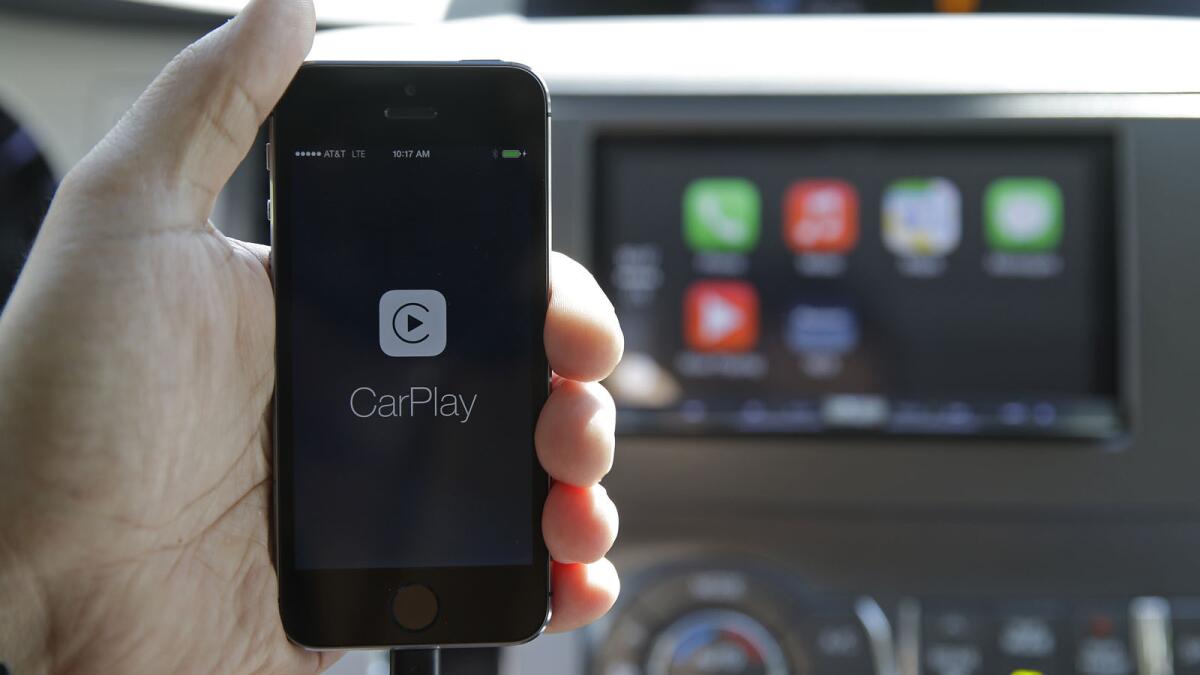Google, Apple compete for a place in your dashboard

Apple and Google want to get in your car.
The tech giants have partnered with automakers to bring technology into vehicles that’s familiar and intuitive. Both sides are hoping to solve a problem that has been vexing drivers for years: The inability to easily and safely access smartphone apps and functions in the car.
So these days, in-dash infotainment systems are essentially extensions of your phone.
It’s a big change in approach for the car industry. The first wave of in-dash systems were typically developed in-house by automakers and flopped because they were balky, confusing and relied on technology that quickly became outdated.
At the same time, smartphones were becoming ubiquitous. It took time for automakers to realize that integrating popular mobile operating systems into their vehicles made the most sense for them and their customers. Tech companies, meanwhile, saw an opportunity to further lock users into their brands and obtain valuable driver data.
“Apple and Google, and a lot of other technology companies, cannot ignore where consumers are truly mobile — and that’s in their cars,” said Thilo Koslowski, vice president and automotive practice leader at Gartner. “Being able to extend their reach to customers when they’re in their vehicles is pretty important.”
Apple in March announced CarPlay, a system that gives iPhone users the ability to easily make calls, use Apple Maps, listen to music and access their messages by touch or voice commands.
Drivers connect their iPhones to their cars through a cable. They can then control CarPlay from their car’s built-in display or by pushing and holding the a button on the steering wheel to activate Siri, the iPhone’s voice system. Certain third-party apps, such as Spotify and MLB At Bat, will also work within CarPlay.
A few months later, Google, which owns the rival Android operating system, responded with its own car connectivity solution. Android Auto features a simple interface, integrated steering wheel controls and new voice actions. Google said its system was designed to minimize distraction so drivers can stay focused.
Several major auto makers have announced that they will support both CarPlay and Android Auto, including Audi, Honda, Nissan, Subaru, Jeep, Dodge, Chrysler, Chevrolet, Mazda and Volvo. Pricing, bundling and rollout for the systems is left up to the automakers.
The aim is to harness what’s found on your mobile device — directions, traffic, music streaming, voice controls, phone calls — and seamlessly integrate them into the driving experience.
Although tech companies have been working with automakers for years, until recently those relationships were loose at best.
It’s “a lot more hassle” for tech giants to delve deeply into cars, which have more complex technical specifications than mobile devices and come with liability concerns and other restrictions, said Andy Gryc, conference director for the Connected Car Expo.
“Those things make it much more challenging,” he said. “But it’s also a very captive audience: People are in their cars for good chunks of the day, so Apple and Google are realizing, ‘If I want to get some dedicated time with the customer, I need to bring my service, bring my apps, bring my ecosystem into the car.”
Although the new smart car platforms have been introduced, the technology is still in the nascent stages and isn’t expected to become widely available in new vehicles for several more months. Currently, only Ferrari has CarPlay installed in new cars; Android Auto-equipped cars are expected to roll off dealer lots before the end of the year.
That’s set off a “bit of a race between the car makers to see who can get out there first,” said Miles Johnson, a Hyundai spokesman.
“We’re trying to be first, and I think we’re going to get there,” he said. “This could be a competitive advantage for us. We’re trying to turn the switch in the first quarter — that’s the target.”
Car owners with older-model cars aren’t out of luck. A number of aftermarket products, such as those made by Alpine Electronics and Pioneer, sync with CarPlay and Android Auto to bring those systems to any car, regardless of model year.
Car makers and tech companies are still figuring out the business model for such partnerships. For now, the two sides have been working together to get the systems up and running, without the tech companies charging automakers for the technology, Koslowski said.
“Once these companies have a stronghold in the automotive space, I wouldn’t say it’s so foreign that these companies would charge,” he said. “I think you’ll see something along those lines in the future, but it’s too early now because it’s new territory.”
As car manufacturers have grown more comfortable opening up their cars to outside, smartphone-centric operating systems, some have stressed that they aren’t giving up complete control.
Ford, which for years has touted its Sync connectivity system despite a slew of customer complaints, has signed on for CarPlay and Android Auto but noted that those in-dash options aren’t enough on their own.
“The infotainment system is a lot more than a place to get music and a place to get navigation,” said Doug VanDagens, global director of connected services solutions at Ford Motor Co. Vehicle in-dash systems also incorporate climate control and safety features such as blind-spot monitoring and pre-braking, he noted.
“There’s no way Google or Apple are prepared to design those systems, and that’s where the automotive companies are really experts,” he said. “Our strategy is having the best blend.”
Twitter: @byandreachang







